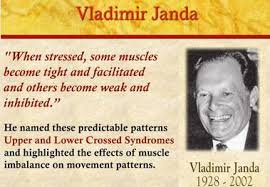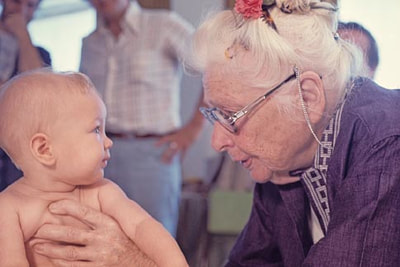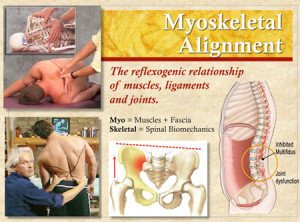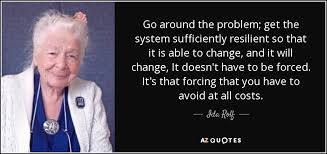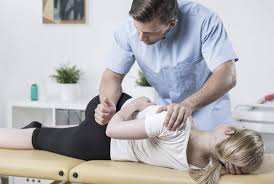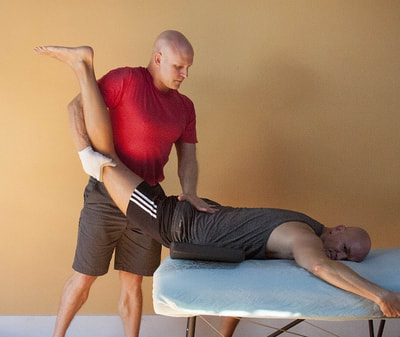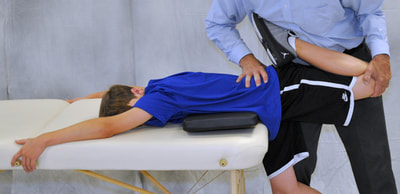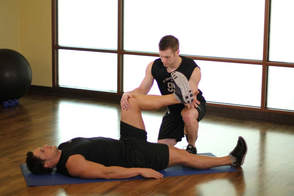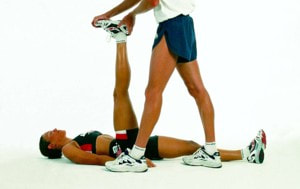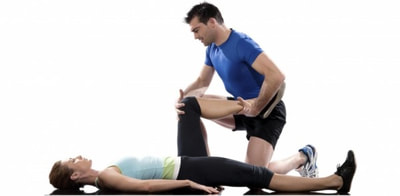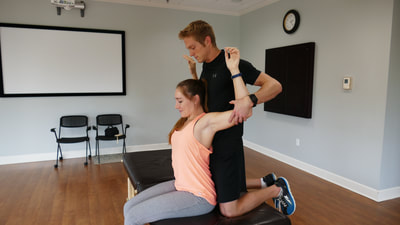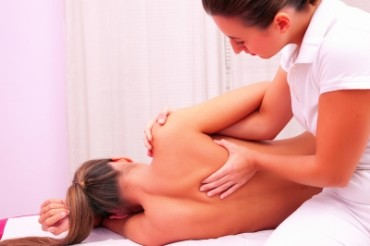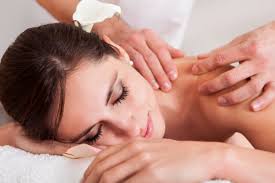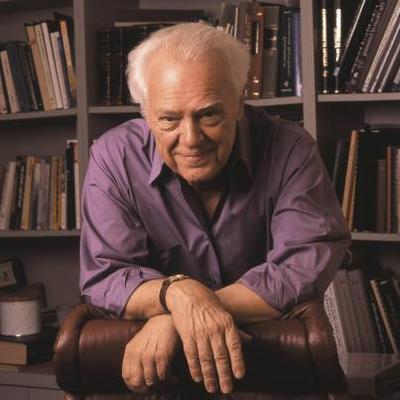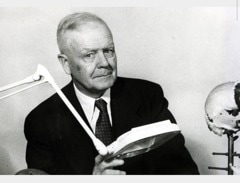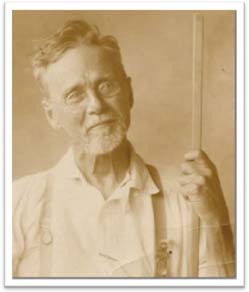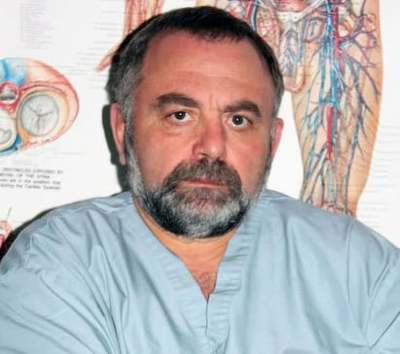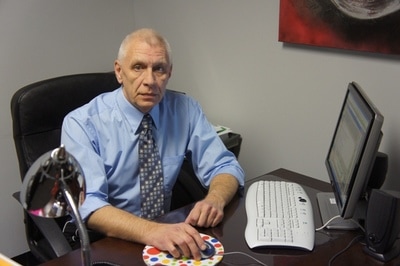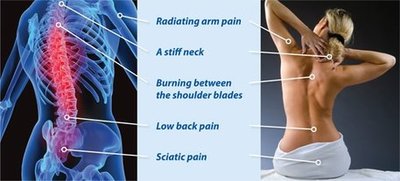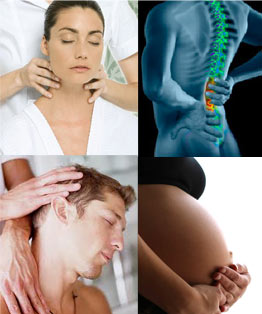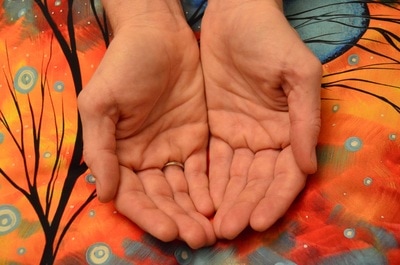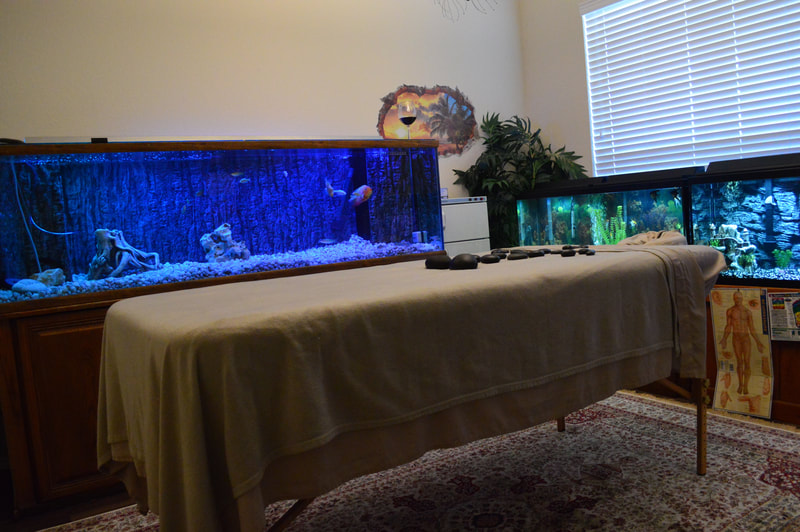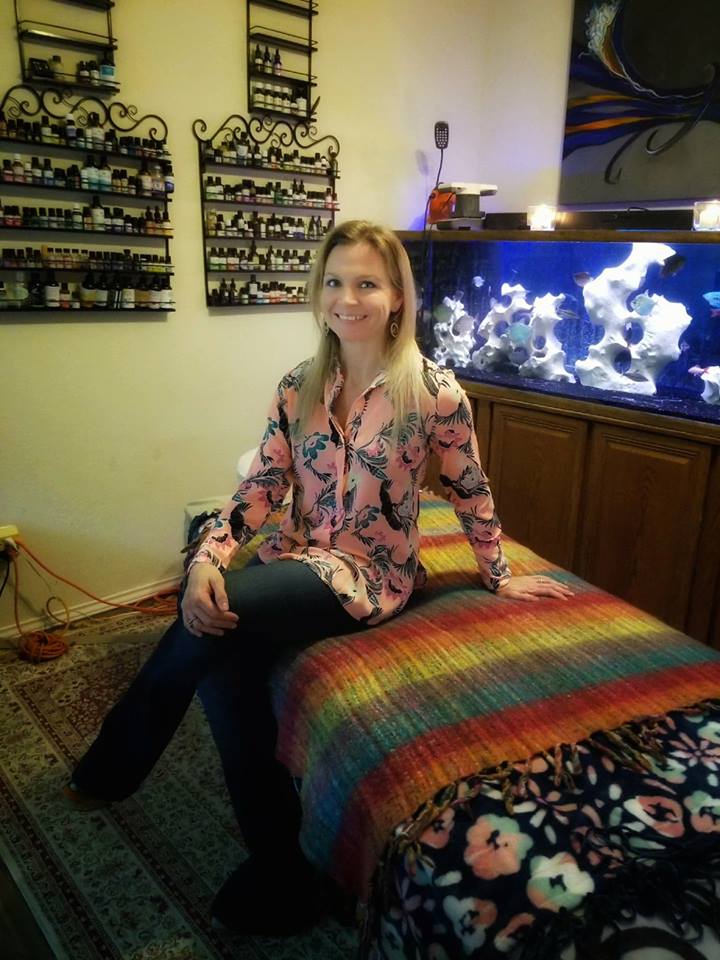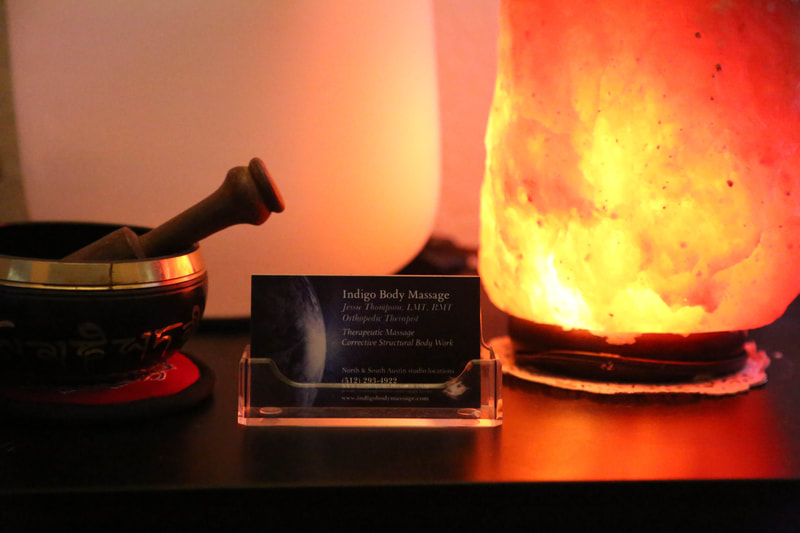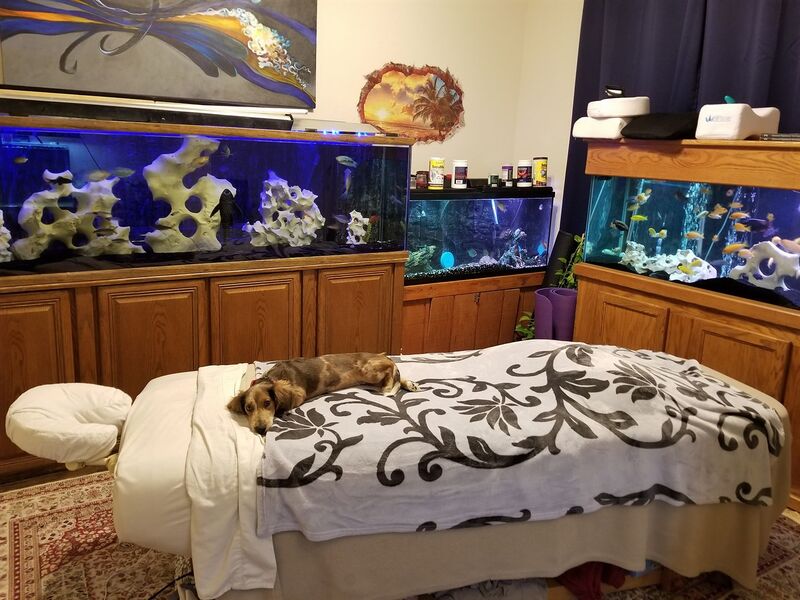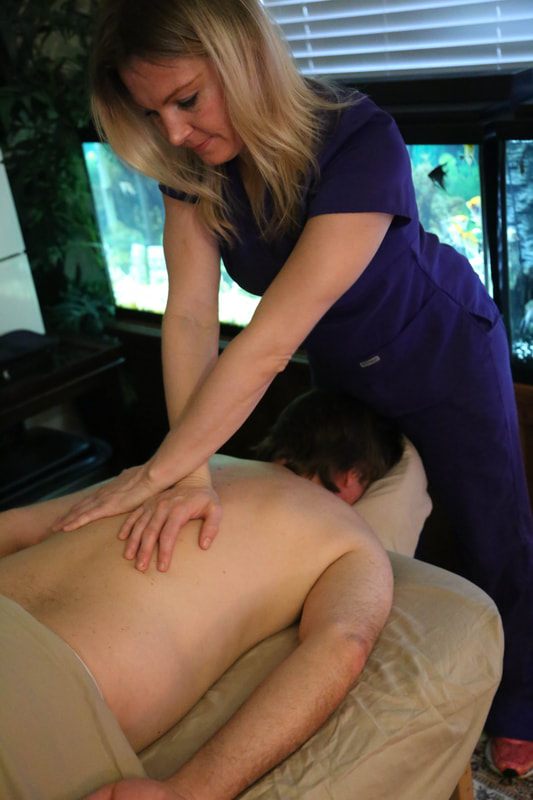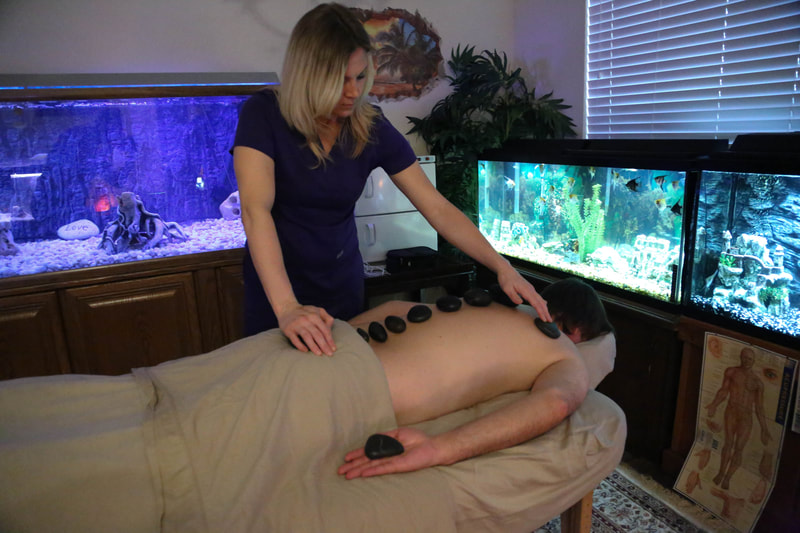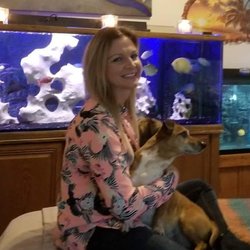Advanced Massage Therapy Modalities
Myoskeletal Alignment Technique (MAT)
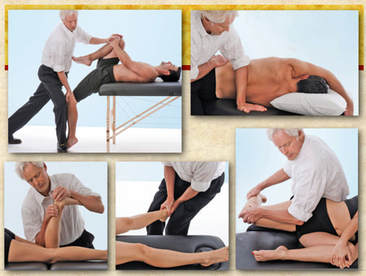
Myoskeletal Alignment Technique (MAT) system brings together the most advanced therapeutic strategies to relieve, and ultimately correct, patterns in the body that lead to pain and deterioration. With MAT therapy, clients can be free from pain, avoiding invasive surgery or toxic pain medications. The source of chronic pain for many arises from very common imbalances and dysfunctional patterns in the musculoskeletal system. Most chronic pain can be relieved with a combination of skilled manual therapy and intelligent corrective exercise.
The human body is comprised of structural systems, such as the anatomy of bones, connective tissue and nerves, as well as functional systems, such as the neural signals that trigger muscular contraction. These systems are inseparably connected in a continuous feedback loop. Without a thorough understanding of how these systems work together, most common musculoskeletal complaints are incorrectly assessed and treated.Benefits of Myoskeletal Alignment Therapy:
The breakthrough Myoskeletal Alignment Technique (MAT) system brings together influential schools of thought that approach the human body from a holistic perspective, working with the reciprocal relationship between mind and body, structure and function.
MAT is in Continuous DevelopmentMyoskeletal Alignment Techniques is a term first coined by Dalton in the early 1980s. However, Dalton never stops developing the MAT system. Over the years, the work of Phillip Greenman, Serge Gracovetsky and many other visionaries in kinesiology and human performance have been integrated into his training programs. By teaching how to identify and correct dysfunctional, neurologically-driven strain patterns before they become pain patterns, he has created one of the most integrative and complete perspectives on pain management.
Vladimir Janda
Vladimir Janda was a European physician in the early and middle twentieth century. He was one of the first medical doctors to approach treatment of pain and musculoskeletal dysfunction with manual therapy and corrective movement.
His key ideas are integrated into MAT:
Key principles of Osteopathy are part of MAT:
Developed by Ida Rolf in the early 1900’s, Rolfing is an approach to therapeutic bodywork that focuses on working with the body’s connective tissues. Appropriate posture and ultimately function are understood as arising from an appropriate balance between the body’s relationship to gravity and the earth.
Key ideas from Rolfing that influence MAT:
The human body is comprised of structural systems, such as the anatomy of bones, connective tissue and nerves, as well as functional systems, such as the neural signals that trigger muscular contraction. These systems are inseparably connected in a continuous feedback loop. Without a thorough understanding of how these systems work together, most common musculoskeletal complaints are incorrectly assessed and treated.Benefits of Myoskeletal Alignment Therapy:
- Relieves chronic pain contributing to weak posture
- Releases trapped nerves from tight muscles, joints and ligaments
- Corrects atrophy, weakness and muscle amnesia in head-forward postures
- Addresses breathing disorders caused by a drooping ribcage
- Lessens pain sensitivity through graded exposure assisted stretching
- Eliminates protective muscle guarding due to joint dysfunction
- Improves sleep by lowering sympathetic nervous system tone
- Creates dynamic, confident posture with innovative restorative techniques
- Corrects sports-related tendon and joint injuries
- Enhances athletic performance through hands-on proprioceptive training
- Changes the brain’s mind about pain through targeted exercise advice
- Prevents chronic neck and back pain due to tension, trauma & weak posture
- Contract-relax techniques can make the nervous system less threatened by the movement… even if muscles aren’t permanently lengthening, trigger points aren’t being obliterated, fascia isn’t stretching, etc.
- Active pain-free therapy signals the brain that the previously painful movement is now safe.
- By doing this repeatedly, the nervous system will often start to disassociate the movement from the pain.
The breakthrough Myoskeletal Alignment Technique (MAT) system brings together influential schools of thought that approach the human body from a holistic perspective, working with the reciprocal relationship between mind and body, structure and function.
MAT is in Continuous DevelopmentMyoskeletal Alignment Techniques is a term first coined by Dalton in the early 1980s. However, Dalton never stops developing the MAT system. Over the years, the work of Phillip Greenman, Serge Gracovetsky and many other visionaries in kinesiology and human performance have been integrated into his training programs. By teaching how to identify and correct dysfunctional, neurologically-driven strain patterns before they become pain patterns, he has created one of the most integrative and complete perspectives on pain management.
Vladimir Janda
Vladimir Janda was a European physician in the early and middle twentieth century. He was one of the first medical doctors to approach treatment of pain and musculoskeletal dysfunction with manual therapy and corrective movement.
His key ideas are integrated into MAT:
- Pain is caused by patterns of overly tonic (tight) antagonist muscles and weak agonists. This distorts joint anatomy and neural function.
- To treat pain, professionals must understand the cohesive relationship between the structure and function of the myoskeletal system.
- Proper treatment entails finding and addressing the cause of pain, rather than focusing on the location of pain.
- True healing comes from promoting functional endurance and balance of muscles, rather than increasing base strength.
Key principles of Osteopathy are part of MAT:
- Every part of the body is connected to every other part of the body through myofascial connective tissue.
- By reducing impediments to proper structure and function, practitioners can assist the body’s ability to defend, repair and rebuild itself.
- Manual therapy includes muscle energy techniques, which combine alternate stretching and isometric contraction.
- Manual therapy also includes palpation feedback techniques called myofascial release. These boost circulation and lymph drainage, as well as promote the corrective stretch reflex of muscles and fascia.
Developed by Ida Rolf in the early 1900’s, Rolfing is an approach to therapeutic bodywork that focuses on working with the body’s connective tissues. Appropriate posture and ultimately function are understood as arising from an appropriate balance between the body’s relationship to gravity and the earth.
Key ideas from Rolfing that influence MAT:
- Optimal function can only be achieved when the body is in proper alignment.
- Correcting misalignment must include working with connective tissue to stretch the body’s fascia.
- A combination of corrective movement and manual therapy is the best way to create lasting improvements in physical alignment and overall well-being.
- Mind and body are deeply intertwined, working together in all posture and movement.
Neuromuscular Therapy Massage (NMT)
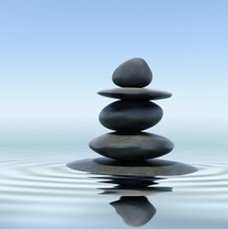
Neuromuscular therapy is a form of soft tissue manipulation that aims to treat underlying causes of chronic pain involving the muscular and nervous systems. This medically-oriented form of massage addresses trigger points (tender muscles points), circulation, nerve compression, postural issues, and biomechanical problems that can be caused by repetitive movement injuries.
Neuromuscular therapy consists of alternating levels of concentrated pressure on the areas of muscle spasm. The massage therapy pressure is usually applied with the fingers, knuckles, or elbow. These time-tested, hands-on techniques are built upon a science-based foundation and guided by clinical evidence. NMT assessments and examinations primarily address issues such as:
Neuromuscular therapy consists of alternating levels of concentrated pressure on the areas of muscle spasm. The massage therapy pressure is usually applied with the fingers, knuckles, or elbow. These time-tested, hands-on techniques are built upon a science-based foundation and guided by clinical evidence. NMT assessments and examinations primarily address issues such as:
- ischemia (tight tissue with reduced blood flow)
- myofascial trigger points (hypersensitive points within muscles that give rise to referred phenomena, including pain)
- neural entrapment (pressure on nerves by muscles and other soft tissues), and nerve compression (pressure on nerves by osseous and other bonelike tissues, such as cartilage or discs).
- postural assessment (assessment of the position of the body as a whole)
- and dysfunctional gait patterns (manner of movement when walking)
- with constant consideration for many other perpetuating factors, such as hydration, nutrition, breathing patterns, and psychologic stress.
Active Isolated Stretching (AIS)
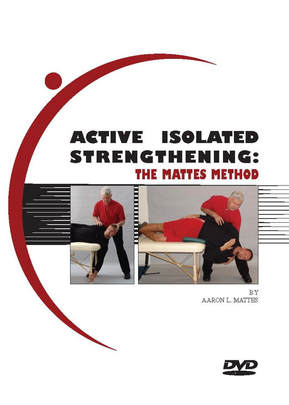
Mattes Method Stretching
Active Isolated Stretching (AIS) is a stretching technique that has been created and perfected by Aaron Mattes in the USA, over the past 40 years. Active Isolated Stretching is one of the methods most used by today’s athletes, massage therapists, personal / athletic trainers and professionals. Active Isolated Stretching allows the body to repair itself and also to prepare for daily activity. The AIS technique involves the method of holding each stretch for no more than 2 seconds.
This method of stretching is also known to work with the body’s natural physiological makeup to improve circulation and increase the elasticity of muscle, joints and fascia.
The Active Isolated Stretching method of muscle lengthening and fascial release is a type of Athletic Stretching Technique that provides effective, dynamic, facilitated stretching of major muscle groups, but more importantly AIS provides functional and physiological restoration of superficial and deep fascial planes. This technique can be used to treat people of all ages & from all walks of life, helping to improve their flexibility, general well-being & quality of life.
Benefits of The Mattes Method The myofascial release & postural realignment facilitated by your Active Isolated Stretching session will reveal muscular imbalances to be corrected.
The Mattes Method of strengthening follows the training specificity principle, by identifying and resolving specific strength and functional deficits. The Mattes Method then employs full range of motion movements to contract and strengthen targeted muscles, while at the same time stretching the opposing muscles. The result is increased muscle strength, joint flexibility and balance across the joints.
Active Isolated Stretching (AIS) is a stretching technique that has been created and perfected by Aaron Mattes in the USA, over the past 40 years. Active Isolated Stretching is one of the methods most used by today’s athletes, massage therapists, personal / athletic trainers and professionals. Active Isolated Stretching allows the body to repair itself and also to prepare for daily activity. The AIS technique involves the method of holding each stretch for no more than 2 seconds.
This method of stretching is also known to work with the body’s natural physiological makeup to improve circulation and increase the elasticity of muscle, joints and fascia.
The Active Isolated Stretching method of muscle lengthening and fascial release is a type of Athletic Stretching Technique that provides effective, dynamic, facilitated stretching of major muscle groups, but more importantly AIS provides functional and physiological restoration of superficial and deep fascial planes. This technique can be used to treat people of all ages & from all walks of life, helping to improve their flexibility, general well-being & quality of life.
Benefits of The Mattes Method The myofascial release & postural realignment facilitated by your Active Isolated Stretching session will reveal muscular imbalances to be corrected.
The Mattes Method of strengthening follows the training specificity principle, by identifying and resolving specific strength and functional deficits. The Mattes Method then employs full range of motion movements to contract and strengthen targeted muscles, while at the same time stretching the opposing muscles. The result is increased muscle strength, joint flexibility and balance across the joints.
- Increase and maintain complete range of motion of the joint.
- Relieve muscle soreness. Light exercise promotes a better supply of blood and oxygen to the muscles than complete rest and should be pursued unless severity of injury to muscles or joints precludes further activity.
- Help improve our capacity for activity. Stretched muscles require less energy for completion of movements.
- Assists in decreasing unnecessary neuromuscular tension, promoting general body relaxation and reducing emotional stress.
- Relieve muscle-joint stiffness associated with the aging process.
- Increased musculotendinous extensibility. Muscle can be stretched 1.6 times its resting length before it tears.
- Elongate the fascia. Fascia provides the binding together muscle support system. Elasticity varies between individuals and is a major reason some individuals experience slower progress in flexibility attainment.
- Help prevent joint sprains, muscle strains or tears including preventing re-injury to previous joint and muscle trauma.
- Major part of the pre-activity warm-up increasing tissue temperature by an increased metabolic rate.
- Part of the warm-down process increase blood flow to the fatigued area, eliminate toxic waste products from cells, reduce soreness, muscle relaxation and additional flexibility improvement.
- Help provide greater potentials of physical and athletic skills.
- Provides an important adjunct toward recovery during the rehabilitation process.
PNF Stretching
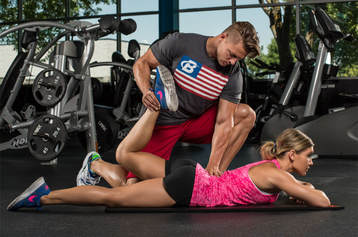
PNF (proprioceptor neuromuscular facilitation) stretching was developed by Dr. Herman Kabat in the 1940s as a means to treat neuromuscular conditions including polio and multiple sclerosis. PNF techniques have since gained popularity with physical therapists and other fitness professionals. It’s easy to understand why. According to research from the University of Queensland, PNF stretching may be the most effective stretching technique for increasing range of motion.
While there are multiple PNF stretching techniques, all of them rely on stretching a muscle to its limit. Doing this triggers the inverse myotatic reflex, a protective reflex that calms the muscle to prevent injury. “PNF causes the brain to go ‘I don’t want that muscle to tear’ and sends a message to let the muscle relax a little more than it would normally.
PNF Techniques
1. Hold-relax
One PNF technique that can trigger the reflex is commonly called “hold-relax.” This involves:
Another common PNF technique is the contract-relax stretch. It is almost identical to hold-relax, except that instead of contracting the muscle without moving, the muscle is contracted while moving. This is sometimes called isotonic stretching.
For example, in a hamstring stretch, this could mean a trainer provides resistance as an athlete contracts the muscle and pushes the leg down to the floor.
3. Hold-relax-contract
A third technique, hold-relax-contract, is very similar to hold-relax, except that after pushing against the stretch, instead of relaxing into a passive stretch, the athlete actively pushes into the stretch. For example, in a hamstring stretch, this could mean engaging the muscles to raise the leg further, as the trainer pushes in the same direction.
Regardless of technique, PNF stretching can be used on most muscles in the body. Stretches can also be modified so you can do them alone or with a partner.
Proprioceptive Neuromuscular Facilitation (PNF) is a more advanced form of flexibility training that involves both the stretching and contraction of the muscle group being targeted. PNF stretching was originally developed as a form of rehabilitation, and to that effect it is very effective.
BenefitsThe positive aspects of PNF stretching are multiple, exceeding the normal stretching benefits. Therefore, performing stretches in PNF mode:
PNF stretching requires the help of a partner or an inanimate object. To perform a PNF stretch, you will alternate between a static stretch-and-hold and an isometric contraction of the muscle being stretched.
Multiple studies have shown that PNF stretching is superior to traditional static stretching in terms of improving range of motion. It is also excellent for targeting specific muscle groups. What’s more, PNF stretching is believed to prevent knots and realign muscle fibers and connective tissue after microscopic damage that typically follows a high-intensity workout.
While there are multiple PNF stretching techniques, all of them rely on stretching a muscle to its limit. Doing this triggers the inverse myotatic reflex, a protective reflex that calms the muscle to prevent injury. “PNF causes the brain to go ‘I don’t want that muscle to tear’ and sends a message to let the muscle relax a little more than it would normally.
PNF Techniques
1. Hold-relax
One PNF technique that can trigger the reflex is commonly called “hold-relax.” This involves:
- Putting a muscle in a stretched position (also called a passive stretch) and holding for a few seconds.
- Contracting the muscle without moving (also called isometric), such as pushing gently against the stretch without actually moving. This is when the reflex is triggered and there is a “6- to 10-second window of opportunity for a beyond ‘normal’ stretch,” Black says.
- Relaxing the stretch, and then stretching again while exhaling. This second stretch should be deeper than the first.
Another common PNF technique is the contract-relax stretch. It is almost identical to hold-relax, except that instead of contracting the muscle without moving, the muscle is contracted while moving. This is sometimes called isotonic stretching.
For example, in a hamstring stretch, this could mean a trainer provides resistance as an athlete contracts the muscle and pushes the leg down to the floor.
3. Hold-relax-contract
A third technique, hold-relax-contract, is very similar to hold-relax, except that after pushing against the stretch, instead of relaxing into a passive stretch, the athlete actively pushes into the stretch. For example, in a hamstring stretch, this could mean engaging the muscles to raise the leg further, as the trainer pushes in the same direction.
Regardless of technique, PNF stretching can be used on most muscles in the body. Stretches can also be modified so you can do them alone or with a partner.
Proprioceptive Neuromuscular Facilitation (PNF) is a more advanced form of flexibility training that involves both the stretching and contraction of the muscle group being targeted. PNF stretching was originally developed as a form of rehabilitation, and to that effect it is very effective.
BenefitsThe positive aspects of PNF stretching are multiple, exceeding the normal stretching benefits. Therefore, performing stretches in PNF mode:
- Can greatly increase flexibility, as it quickens and stimulates the neuromuscular mechanisms response while ensuring that both the antagonists and agonists get alternately relaxed and contracted.
- In comparison with simple passive or static stretching, show that PNF provides higher raise of ROM (range of motion).
- Adds to the strength and of the employed muscles
- Is beneficial for the stability of joints
- Can significantly reduce the risks of a joint or muscle injury, provided that the exercise routine is performed correctly
- PNF stretching has been proven to improve active and passive range of motion. It can be used to supplement daily, static stretching and has been shown to help athletes improve performance and make speedy gains in range of motion. Not only does it increase flexibility, but it can also improve muscular strength
PNF stretching requires the help of a partner or an inanimate object. To perform a PNF stretch, you will alternate between a static stretch-and-hold and an isometric contraction of the muscle being stretched.
Multiple studies have shown that PNF stretching is superior to traditional static stretching in terms of improving range of motion. It is also excellent for targeting specific muscle groups. What’s more, PNF stretching is believed to prevent knots and realign muscle fibers and connective tissue after microscopic damage that typically follows a high-intensity workout.
Orthopedic Massage
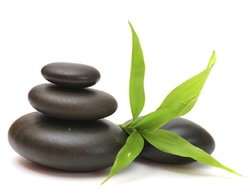
Orthopedic massage is a medical massage that involves therapeutic assessment, manipulation and movement of loco-motor soft tissue to reduce pain and dysfunction. Restoring structural balance throughout the body allows us to focus on both prevention and rehabilitation of musculoskeletal dysfunctions.
Orthopedic Massage Therapy is a multidisciplinary approach to relieving muscular and soft tissue pain, dysfunction, and injuries. It is also utilized to help clients regain and improve their health and fitness. A multidisciplinary approach is far more powerful than one technique or form of treatment. This is one of my personal favorite massage modalities to use and I often incorporate this into most of my work because of its effectiveness and proven results.
Orthopedic massage differs from ordinary massage therapy in that it is a type of massage therapy which is focused on treating painful conditions which affect the soft tissues of the body. Orthopedic massage focuses on problems with the client's musculoskeletal system. The therapist may release tight muscles, help to stretch shortened muscles and tendons, and decompress joints. The goal is to normalize the soft tissues of the body, both to treat specific conditions and to keep clients generally healthy and fit. He or she may integrate a range of techniques to treat these conditions, ideally adapting his or her style for each client, as every person's body is slightly different.
Orthopedic Massage Therapy is a multidisciplinary approach to relieving muscular and soft tissue pain, dysfunction, and injuries. It is also utilized to help clients regain and improve their health and fitness. A multidisciplinary approach is far more powerful than one technique or form of treatment. This is one of my personal favorite massage modalities to use and I often incorporate this into most of my work because of its effectiveness and proven results.
Orthopedic massage differs from ordinary massage therapy in that it is a type of massage therapy which is focused on treating painful conditions which affect the soft tissues of the body. Orthopedic massage focuses on problems with the client's musculoskeletal system. The therapist may release tight muscles, help to stretch shortened muscles and tendons, and decompress joints. The goal is to normalize the soft tissues of the body, both to treat specific conditions and to keep clients generally healthy and fit. He or she may integrate a range of techniques to treat these conditions, ideally adapting his or her style for each client, as every person's body is slightly different.
Craniosacral Therapy (CST)
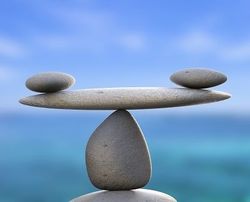
Craniosacral Therapy, or CST as it is generally called, has its roots back in the nineteenth century. Originating in Andrew Taylor Still’s system of osteopathic medicine, it owes much to subsequent pioneers of technique, such as William G. Sutherland who extended Dr. Still's system into cranial osteopathy. This was refined and codified by Harold Magoun in the 1950’s and taught by him to Dr. John E. Upledger in the late 60’s.
John E Upledger took on and developed these techniques into what he called ‘CranioSacral Therapy’, a powerful yet simplified system of treatment capable of being learned by anyone of good intent wishing to study the system. Craniosacral therapy (CST) was pioneered and developed by osteopathic physician Dr. John E. Upledger following extensive scientific studies from 1975 to 1983 at Michigan State University, where he served as a clinical researcher and Professor of Biomechanics. CST is a gentle, hands-on method of evaluating and enhancing the functioning of a physiological body system called the craniosacral system - comprised of the membranes and cerebrospinal fluid that surround and protect the brain and spinal cord. All events in life are perceived by the body through the sensory network of nerves going into the brain. These events include trauma of any nature; injury, physical or emotional trauma, or could be chemical or biological in nature. Everything the body experiences, is recorded in the tissue and may cause restrictions. These may then manifest as disease, dysfunction or poor healing, as the body’s own healing and self-corrective techniques are overwhelmed and therefore less efficient. Using a soft touch generally no greater than 5 grams, or about the weight of a nickel, practitioners release restrictions in the craniosacral system to improve the functioning of the central nervous system.
CST clears restrictions in the fascial tissues of the body. These are the soft tissue layers that are continuous throughout the whole body and envelop every organ, muscle and bone down to the individual cells. As a light, hands-on approach, CST harmonizes with the body's natural hydraulic forces and movements, thus encouraging and enhancing the body's inherent natural healing abilities. This gentle releasing of chronic tensions within the body can effect major changes in both physical and emotional well-being.
By complementing the body's natural healing processes, CST is increasingly used as a preventive health measure for its ability to bolster resistance to disease, and is effective for a wide range of medical problems associated with pain and dysfunction. Craniosacral therapy enhances the function of the Autonomic Nervous System, which consists of the sympathetic and parasympathetic systems. The body heals and repairs itself when the parasympathetic is dominant i.e. when we are most relaxed or asleep. The sympathetic nervous system, known as the “fight or flight” system is affected by the modern way of living and this can lead to undue stress. At worst this can be a chronic debilitating condition as we all know. Relaxation has long been valued for its healing and restorative effects on the body and encouraging deep states of relaxation in the body is easily facilitated by craniosacral therapy. The main centers of the nervous system lie in the cranial and sacral regions and the gentle manipulations of CST modulate the balance between the sympathetic and parasympathetic systems, optimizing the function of both.
Craniosacral therapy requires no equipment, only the gentle hands and clear intention of the therapist. Everyone can avail themselves of its benefits, from babies to centenarians (and beyond). CST is useful as both a primary treatment method or as part of a treatment program combined with other traditional or complementary techniques.
John E Upledger took on and developed these techniques into what he called ‘CranioSacral Therapy’, a powerful yet simplified system of treatment capable of being learned by anyone of good intent wishing to study the system. Craniosacral therapy (CST) was pioneered and developed by osteopathic physician Dr. John E. Upledger following extensive scientific studies from 1975 to 1983 at Michigan State University, where he served as a clinical researcher and Professor of Biomechanics. CST is a gentle, hands-on method of evaluating and enhancing the functioning of a physiological body system called the craniosacral system - comprised of the membranes and cerebrospinal fluid that surround and protect the brain and spinal cord. All events in life are perceived by the body through the sensory network of nerves going into the brain. These events include trauma of any nature; injury, physical or emotional trauma, or could be chemical or biological in nature. Everything the body experiences, is recorded in the tissue and may cause restrictions. These may then manifest as disease, dysfunction or poor healing, as the body’s own healing and self-corrective techniques are overwhelmed and therefore less efficient. Using a soft touch generally no greater than 5 grams, or about the weight of a nickel, practitioners release restrictions in the craniosacral system to improve the functioning of the central nervous system.
CST clears restrictions in the fascial tissues of the body. These are the soft tissue layers that are continuous throughout the whole body and envelop every organ, muscle and bone down to the individual cells. As a light, hands-on approach, CST harmonizes with the body's natural hydraulic forces and movements, thus encouraging and enhancing the body's inherent natural healing abilities. This gentle releasing of chronic tensions within the body can effect major changes in both physical and emotional well-being.
By complementing the body's natural healing processes, CST is increasingly used as a preventive health measure for its ability to bolster resistance to disease, and is effective for a wide range of medical problems associated with pain and dysfunction. Craniosacral therapy enhances the function of the Autonomic Nervous System, which consists of the sympathetic and parasympathetic systems. The body heals and repairs itself when the parasympathetic is dominant i.e. when we are most relaxed or asleep. The sympathetic nervous system, known as the “fight or flight” system is affected by the modern way of living and this can lead to undue stress. At worst this can be a chronic debilitating condition as we all know. Relaxation has long been valued for its healing and restorative effects on the body and encouraging deep states of relaxation in the body is easily facilitated by craniosacral therapy. The main centers of the nervous system lie in the cranial and sacral regions and the gentle manipulations of CST modulate the balance between the sympathetic and parasympathetic systems, optimizing the function of both.
Craniosacral therapy requires no equipment, only the gentle hands and clear intention of the therapist. Everyone can avail themselves of its benefits, from babies to centenarians (and beyond). CST is useful as both a primary treatment method or as part of a treatment program combined with other traditional or complementary techniques.
Russian Medical Massage;
The "V Method"
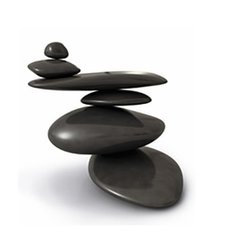
Russian massage techniques are similar to most sports massage practices, but they involve slower, softer motions. Russian massages focus on the use of friction to generate heat within the body. The massage therapist combines this with vibration and vibrating friction to ease muscle pain and stiffness. It also relieves mental stress and can help with anxiety.
This choreographed use of techniques and muscle Assessment uses the basic strokes of classical massage, changing them so each stroke provides the client with the least invasive and most comfortable treatment.
Russian Medical Massage, the V- method; RMM is a clinical and physiological treatment used for reasons such as muscle or movement disorders, soreness, tiredness and fatigue, myalgia (muscle pain), emotional and physical stress, headaches and more. This type of massage therapy is strictly based on anatomical structure and physiology of the human body. The RMM is unique because it includes so many different therapeutic modalities including Swedish, neuromuscular therapy, pressure-point treatment, deep tissue, reflexology, and many others. I prefer using this modality on athletes because it is highly effective with muscle recovery and the sore and achy pain that athletes often incur from such regular physical activity.
The V-method presents a combination of different hand manipulations in a particular sequence and is very useful and effective in treating patient and clients with specific areas of pain as well as stress management.
This choreographed use of techniques and muscle Assessment uses the basic strokes of classical massage, changing them so each stroke provides the client with the least invasive and most comfortable treatment.
Russian Medical Massage, the V- method; RMM is a clinical and physiological treatment used for reasons such as muscle or movement disorders, soreness, tiredness and fatigue, myalgia (muscle pain), emotional and physical stress, headaches and more. This type of massage therapy is strictly based on anatomical structure and physiology of the human body. The RMM is unique because it includes so many different therapeutic modalities including Swedish, neuromuscular therapy, pressure-point treatment, deep tissue, reflexology, and many others. I prefer using this modality on athletes because it is highly effective with muscle recovery and the sore and achy pain that athletes often incur from such regular physical activity.
The V-method presents a combination of different hand manipulations in a particular sequence and is very useful and effective in treating patient and clients with specific areas of pain as well as stress management.
Medical Massage

The term Medical Massage and therapeutic Massage means basically the same thing. It is called medical massage because the founders and researchers who developed this method called it Medical Massage. Therapy means health benefits to the human body and that is what medical massage therapy stands for. Medical Massage could also be called segment - reflex massage. Massage Therapy encompasses different disciplines, specializations and expertise. For example, Full Body Medical Stress Management Massage associates important methods in managing side effects of stress including high blood pressure, anxiety, tension headaches, ulcers as well as prevention of aforementioned pathologies.
Medical/Therapeutic Massage deals with procedures designed to treat back and limb disorders that could be results of sports related injuries, industrial injuries, car accidents, etc. It is important to realize that medical massage therapy is a simple, very powerful and safe therapeutic tool.
Why Medical Massage?
Medical massage is one of the most effective and simple tools for reaching rapid and sustained results in various disorders including sciatic nerve neuralgia, hypertension, impingement syndromes, and lower back disorders. Medical massage is a comprehensive method of soft tissue mobilization consisting of connective tissue massage (fascia mobilization), muscular mobilization, trigger point therapy, skin mobilization, and other components. It also offers techniques that allow the therapist to palpate and detect abnormalities in the skin, fascia, muscles and for the elimination of tension in fascia and muscles, trigger point therapy, and reduction of high skin density. The elimination of these abnormalities most often leads to immediate results, including the reduction of pain, and release of nerve impingements.
Medical/Therapeutic Massage deals with procedures designed to treat back and limb disorders that could be results of sports related injuries, industrial injuries, car accidents, etc. It is important to realize that medical massage therapy is a simple, very powerful and safe therapeutic tool.
Why Medical Massage?
Medical massage is one of the most effective and simple tools for reaching rapid and sustained results in various disorders including sciatic nerve neuralgia, hypertension, impingement syndromes, and lower back disorders. Medical massage is a comprehensive method of soft tissue mobilization consisting of connective tissue massage (fascia mobilization), muscular mobilization, trigger point therapy, skin mobilization, and other components. It also offers techniques that allow the therapist to palpate and detect abnormalities in the skin, fascia, muscles and for the elimination of tension in fascia and muscles, trigger point therapy, and reduction of high skin density. The elimination of these abnormalities most often leads to immediate results, including the reduction of pain, and release of nerve impingements.
|
Indigo Body Massage & Orthopedics
https://linktr.ee/IndigoBody [email protected] (512) 293-4922 Convenient out-calls at your home, office or place of business office or 9442 N Capital of Texas Highway Plaza One, Suite 500 Austin, TX 78759 Mon - Sat - 9:00 a.m.– 7:30 p.m. Sundays - Private Request Only |
Pet Friendly
Location9442 Capital of Texas Highway North, Plaza One, Suite 500
Austin, TX 78759 |
|

